The impact of sanctions on Russia

Last weekend, E.U. leaders decided to tighten sanctions against Russia after its armed forces launched an invasion of Ukraine. Over the past week, one major company after another has announced shutdowns of Russian factories and the closure of each company's operations in Russia. Apart from the moral, one crucial reason is that it will be challenging to do business in the country when several Russian banks can no longer use the Swift system. That means that international payments are made impossible.
In this weekly trading note from Carlsquare, we elaborate on the following topics, indices, and stocks:
- The impact of sanctions on Russia
- Reduce risk by reducing European exposure
- Strong USD as a currency of safe-haven and economic development
- No energy sanction, but will they come?
- Wheat is flying
- OMXS30 below 2 000
- Swedish large-cap stocks struck with limited Russian exposure
- S&P 500 is doing better…but still under pressure
- Nasdaq 100 under pressure as rates are coming down
Last weekend, E.U. leaders decided to tighten sanctions against Russia after its armed forces launched an invasion of Ukraine. Over the past week, one major company after another has announced shutdowns of Russian factories and the closure of each company's operations in Russia. Apart from the moral, one crucial reason is that it will be challenging to do business in the country when several Russian banks can no longer use the Swift system. That means that international payments are made impossible. It also hinders Russia from getting a hand of their capital reserves in, e.g., USD. Another consequence is that several Russians now lose their jobs. Volvo A.B.s factory in Kaluga and administration alone had 1 300 employees.
How should one act as a portfolio manager in light of the war and the sanctions on Russia? It is fair to say that the risks are difficult to assess. It is impossible to calculate how much companies and communities will lose from the boycott of Russia and Belarus by the United States, almost all European countries, Canada, Japan, Australia, and New Zeeland. The decisive factor is how long the invasion of Ukraine lasts and the outcome. Will it be weeks, months, or even years? It can probably last for months, judging from the war scenario so far.
Reduce risk by reducing European exposure
A relatively easy decision for a portfolio manager is to reduce risk by selling European equities and increasing the proportion of liquidity in the funds. Europe will be the second to suffer (after Russia, whose economy seems to be on the verge of collapse).
The fact that European stock markets have fallen sharply during the first week of the Ukrainian war seems justified as European countries accounted for 46% of Russia's trade (exports and imports) in 2019. China is Russia's second most important trading partner, accounting for around 10% of its total trade. Belarus and Turkey follow it with 5% each, South Korea with 3 1/2, and India with about 2% of Russia's trade.
Stock indices performance on Friday, March 4, 2022, in one week and one month

Looking at the price performance for significant stock indices, many portfolio managers and other investors seem to have made the easy choice, selling European stocks while keeping the North American part of the portfolio unchanged. France (CAC40) and Germany (DAX) indices have lost 4-5 percent of their value in the last week and 15-18 percent so far this year. The U.S. stock exchanges that led the decline in January now see relatively limited share price movements.
The Moscow stock exchange had no option but to keep closed for the past week. The Dow Jones Russia GDR has fallen by 92 percent in value over the past week and almost 97 percent this year. It says something about the impact of the sanctions.
That Europe is much more vulnerable to a trade embargo against Russia than the United States is reflected in the performance of the major stock indices over the past week. On top of that, the Euro has weakened significantly against the CHF, USD, and JPY, all considered safe-haven currencies.
EUR/CHF, five-year weekly chart
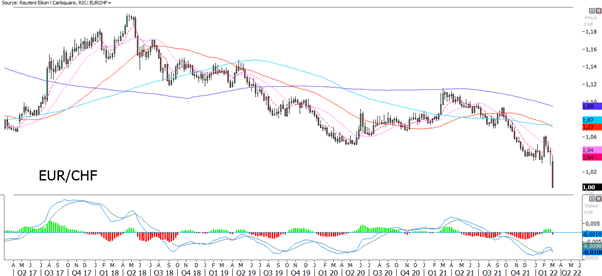
EUR/JPY, five-year weekly chart
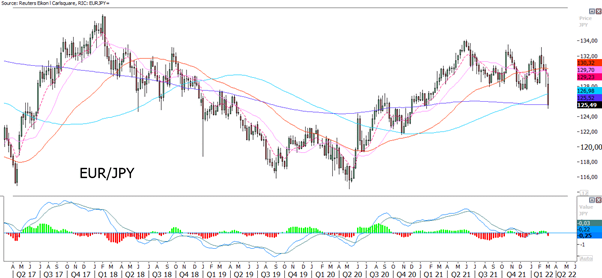
Strong USD as a currency of safe-haven and economic development
The U.S. Labor Bureau released better-than-expected employment data for February on Friday, March 4 (678,000 new jobs against the Consensus forecast of 423,000 new jobs). At the same time, the January 2021 jobs number was revised up to 481,000 new jobs from 467,000 previously. The USD strengthened against the EUR. The EUR, in its turn, dived due to the Russian sanctions before these U.S. employment numbers were released.
EUR/USD exchange rate from August 5, 2021, to March 4, 2022
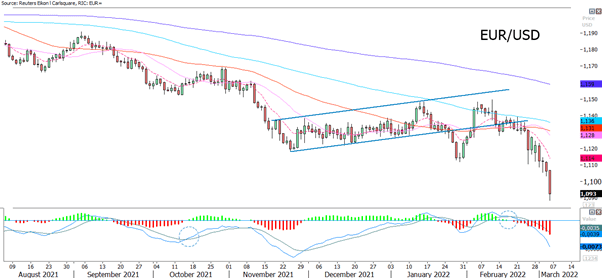
The weekly five-year chart below shows that the EUR/USD closed last week below the 1.10-level. Are the local lows from the first half of 2020 round 1.08 next?
EUR/USD, weekly five-year chart
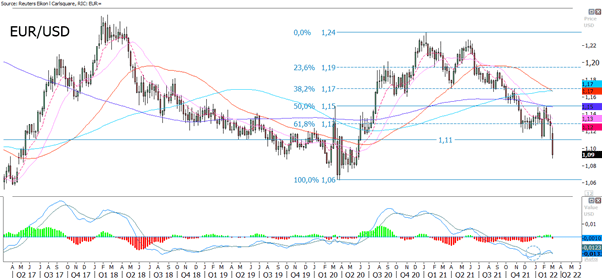
No energy sanction, but will they come?
Russia's primary export goods are petroleum, natural gas, metals, wood and wood products, chemicals, and military manufacture. The sky seems still to be the limit also for the Brent oil price. There have been no energy sanctions so far on Russia. If it materializes, it is likely to continue to drive energy prices, such as oil. Equities are likely to be hurt by such a scenario, as input prices are likely to increase, and to that, you could add further inflation.
Russia will try to sell more oil and natural gas to China. But for China, trade with the U.S. and E.U. countries is much more important than trade with Russia. By purchasing oil from Russia, China is at risk of being negatively treated by the U.S. and E.U. on trade matters. One reason for the China-Russia friendship might be that China plan soon to try to annex Taiwan. Chinas PM Xi Jinping was aware of Russia's intentions for Ukraine before the war started, it now seems.
Brent oil future (in USD) August 5, 2021, to March 4, 2022
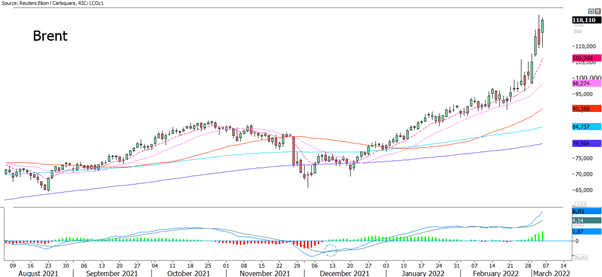
Brent oil future (in USD), weekly five-year price graph
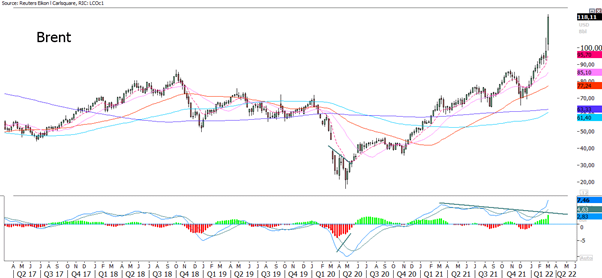
Wheat is flying
The countries that boycott Russia (the United States and most E.U. and NATO countries etc.) control 63 percent of global GDP, 35 times more than Russia. The Russian economy is being hit hard by Western sanctions. The question is whether Putin can keep the war in Ukraine going for several months.
Wheat future (in USD) weekly five-year chart
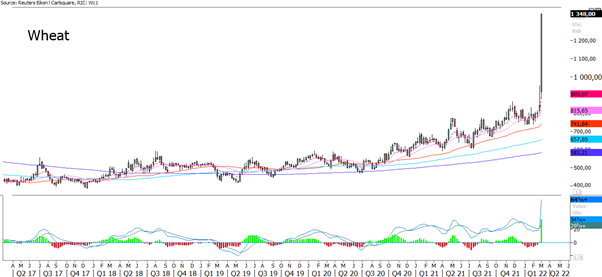
The spike in the wheat price illustrates the Ukraine war's effects on commodities. Russia and Ukraine are both top-ten global exporters of wheat.
May MA20 save DAX?
European equities are, as mentioned clearly, under selling pressure. DAX was down 4,4 percent on Friday and closed near the intraday low. Who wanted to have a long position over the weekend? Not that many. But it could create buying opportunities.
DAX (in EUR) June 15, 2021, to March 4, 2022
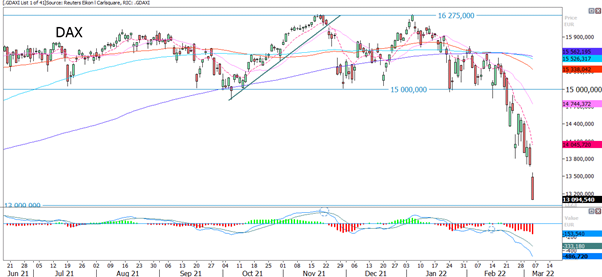
In the weekly chart, one can also see how DAX closed on MA200. Will it hold?
DAX (in EUR), weekly five-year price graph
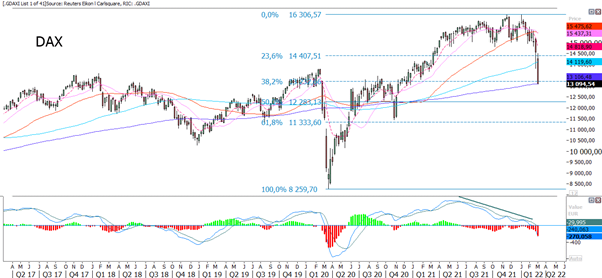
OMXS30 below 2 000
OMXS30 closed last Friday below the psychologically important two 000-level. From the top on January 4, the index is down 19,3 percent.
OMXS30 (in SEK) June 15, 2021, to March 4, 2022
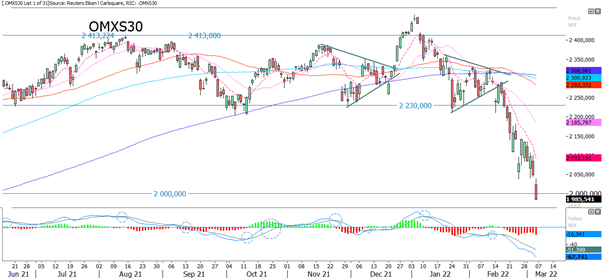
OMXS30 closed below MA100 and Fibonacci 38.2 as MACD has generated a sell signal in the weekly chart. Not good. Is Fibonacci 50 next?
OMXS30 (in SEK), weekly five-year price graph
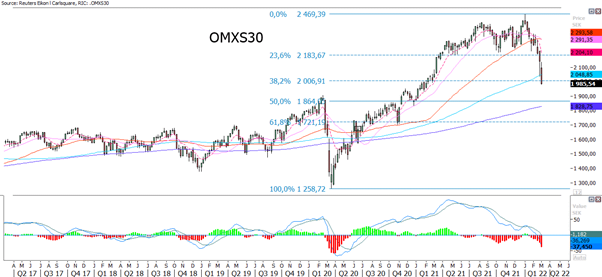
Swedish large-cap stocks struck with limited Russian exposure
As a result of the sanctions against Russia and the corporate stance on Ukraine, many large companies are now shutting down their factories, shops, and other operations in Russia. One example of a stock that has taken a big hit in share price due to the Russia link is Volvo.
The picture is similar for Volvo AB shares. Due to its Russian exposure with a truck factory in Kaluga 180 km southwest of Moscow, the Volvo B-share has lost 13 percent of its value in the last week. The share price decline in Volvo AB has been 20 percent in the previous month. About 3,5 percent of Volvo Group revenues have come from Russia.
Volvo B (in SEK) June 15, 2021, to March 4, 2022

Mini Futures
The share is approaching support in the weekly chart made out of MA200 and Fibonacci 50. May this be an opportunity?
Volvo (in SEK), weekly five-year price graph

A company in a completely different industry but with similar exposure to Russia is H&M, with around 3% of group revenues coming from the country. In total, H&M has about 170 stores in Russia. The company has decided to pause its sales in Russia temporarily. H&M's share price has fallen in much the same way as Volvo (16% in the last week and 18% in a month). On Friday, there was a Doji, implying uncertainty of the next move.
H.M. B share price graph (in SEK) June 15, 2021, to March 4, 2022
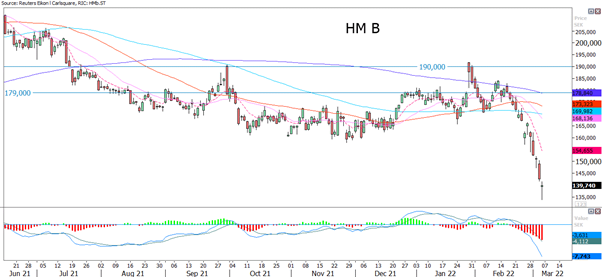
In the weekly chart, one can see how the H.M.stock is approaching support around SEK 132:
H.M. B (in SEK), weekly five-year share price graph

To sum up, European equities in general and companies with operations in Russia, in particular, have been struck at share price over the past week. It may be time to buy these stocks if they are among your favorites. But it may take time before these war and sanctions effects are behind us.
S&P 500 is doing better…but still under pressure
The U.S. stock market has managed better. Nevertheless, the previous week ended down. The daily chart below shows that the broad S&P 500 is still under pressure by a falling EMA9 and MA20. Fibonacci 23.6 is the first level of support on the downside.
S&P 500 index graph (in USD) August 5, 2021, to March 4, 2022
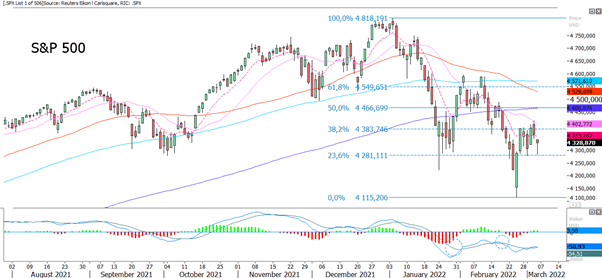
Fibonacci 23.6 serves as the first level of support on the downside in the weekly chart.
S&P 500 (in USD), weekly five-year price graph
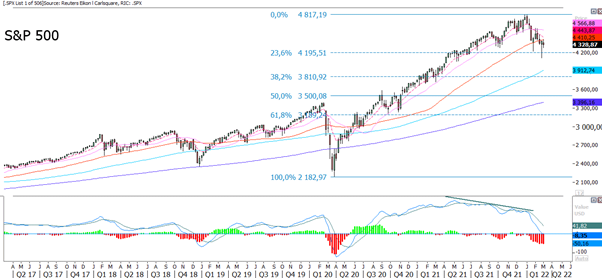
Nasdaq 100 under pressure as rates are coming down
Both shorter and longer rates in the U.S. have come down. It should work in favor of Nasdaq with more significant exposure to growth companies than, e.g., S&P 500. It has not been the case, though. As shown, Nasdaq is pressured downwards by a falling EMA9 and MA20 and closed Friday's trading below the psychologically important 14 000-level.
Nasdaq 100 (in USD) August 5, 2021, to March 4, 2022

Rising MA100 serves as the first level of support in the weekly chart, followed by Fibonacci 38.2:
Nasdaq 100 (in USD), weekly five-year price graph

The full name for abbreviations used in the previous text:
EMA 9: 9-day exponential moving average
Fibonacci: There are several Fibonacci lines used in technical analysis. Fibonacci numbers are a sequence of numbers in which each successive number is the sum of the two previous numbers.
MA20: 20-day moving average
MA100: 100-day moving average
MA200: 200-day moving average
MACD: Moving average convergence divergence
Risks
Important notice:
This information is neither an investment advice nor an investment or investment strategy recommendation, but advertisement. The complete information on the trading products (securities) mentioned herein, in particular the structure and risks associated with an investment, are described in the base prospectus, together with any supplements, as well as the final terms. The base prospectus and final terms constitute the solely binding sales documents for the securities and are available under the product links. It is recommended that potential investors read these documents before making any investment decision. The documents and the key information document are published on the website of the issuer, Vontobel Financial Products GmbH, Bockenheimer Landstrasse 24, 60323 Frankfurt am Main, Germany, on prospectus.vontobel.com and are available from the issuer free of charge. The approval of the prospectus should not be understood as an endorsement of the securities. The securities are products that are not simple and may be difficult to understand. This information includes or relates to figures of past performance. Past performance is not a reliable indicator of future result.
